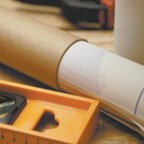Sewer Planning For a Growing Peoria

Most city residents take sewer service for granted. Some may not even know what happens to wastewater when it “goes down the drain.” This attitude is understandable because sewer systems typically are designed to last a long time with little maintenance. However, designing a sewer to serve for many years requires careful planning and forethought about where future development may occur.
A typical sanitary sewer is designed and constructed to serve a natural drainage area, similar to a storm water drainage system. The underground pipes are laid at a gradual downhill slope and increase in size as they extend further downstream and other branch pipes join in. This underground pipe network is called a “wastewater collection system.” For a city the size of Peoria, the collection system may contain more than 400 miles of pipe.
The collection system brings wastewater from all parts of the city to a common point for treatment and water reclamation before it’s returned as clean water to the river. The collection system’s largest pipes usually are called “interceptors.” In Peoria, there are two large interceptors, each seven feet in diameter. All the city’s wastewater flows through the interceptors into the treatment plant. More than 80 years ago, engineers designed these sewers with adequate capacity to carry the wastewater generated within the entire drainage areas flowing into each interceptor. This planning was done very well; as the city has grown over the years, these sewer networks have been extended farther and farther to the upstream end of these natural drainage areas.
During the past 10 years, new development has pushed beyond the natural service areas of the city’s sanitary sewer system, which has created new challenges and constraints. Since most of these new areas—especially those north and west of the Route 6 bypass—naturally drain toward the north or west, they weren’t included in the planning for the city’s original collection system. If Peoria continues to expand farther north and west, the long-term solution for wastewater service in these areas would be to build another treatment plant several miles out of town. However, since the existing treatment facilities have some reserve capacity, an interim solution can be achieved by adding new pump stations and force mains to bring the wastewater back into the original drainage areas. This initially was done with the Allen Road pump station that serves Growth Cell 1 and more recently with the Trigger Road pump station that serves a portion of Growth Cell 3.
The capacity of these pump stations is limited since the downstream trunk sewers that receive the pumped wastewater also have limited reserve capacity. This is because it never was anticipated that those sewers would serve new areas beyond their natural service boundaries. As new developments to the north and west continue to create additional wastewater flows, some additional growth can be accommodated by providing peak flow storage at the pump stations. During normal conditions, all flow would continue to be pumped directly as it comes into the station. But during extreme peak flow conditions (once a year or less), some flow could be temporarily held in the storage facility and pumped back later after the high flows have returned to normal. This concept currently is being planned for some future developments on the northwest edge of Peoria.
Eventually, the original sewer system will be stretched to the limit, and a new treatment plant to serve these additional areas will be required. So to plan ahead for that eventuality, the new trunk sewers being built are being sized properly to serve all their natural drainage area, just as those other sewers were designed 80 years ago. Then, someday, the pump stations can be turned off, and the wastewater will drain by gravity to a new treatment facility. IBI

